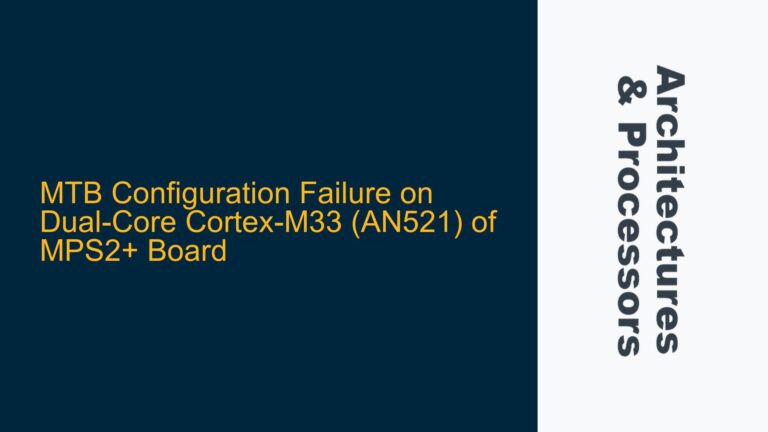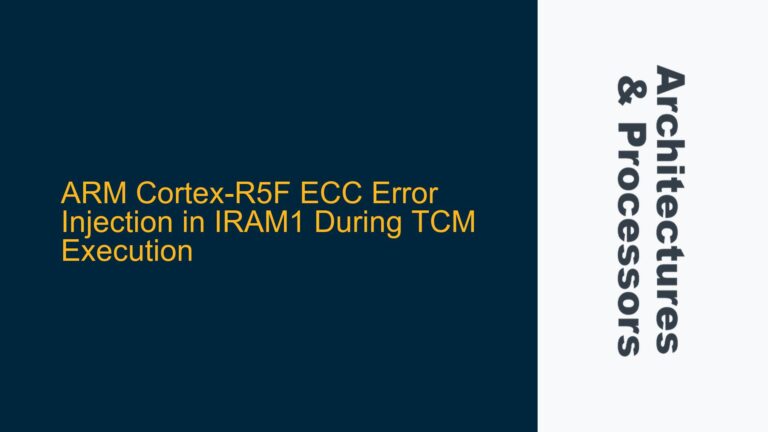ARM-Based Power Management Challenges in Edge Computing
Edge computing environments demand highly efficient power management techniques due to their constrained resources and the need for prolonged battery life. ARM-based processors are widely used in these environments due to their power efficiency and scalability. However, developing and validating new power-saving techniques for ARM-based systems requires robust simulation tools and frameworks that can accurately model the power behavior of these processors. The primary challenge lies in identifying tools that can simulate power management strategies without oversimplifying the complexities of ARM architectures, such as dynamic voltage and frequency scaling (DVFS), power gating, and clock gating. Additionally, the tools must support the integration of custom power management algorithms and provide detailed power consumption reports to validate the effectiveness of the proposed techniques.
The complexity of ARM-based systems, particularly in edge computing, stems from the need to balance performance and power consumption. ARM processors often operate in multi-core configurations with shared caches, memory subsystems, and interconnect fabrics, all of which contribute to the overall power profile. Simulating these components accurately requires tools that can model not only the processor cores but also the surrounding system-on-chip (SoC) components, such as the memory hierarchy, interconnects, and peripherals. Furthermore, the simulation framework must account for real-world workloads and usage patterns, which can vary significantly in edge computing scenarios.
Limitations of Existing Tools and Frameworks
One of the most commonly used tools for system-level simulation is Gem5. While Gem5 is highly versatile and supports a wide range of ARM-based configurations, its complexity and lack of comprehensive documentation make it challenging to use for power management research. Gem5 requires significant expertise to configure and extend, particularly for modeling custom power management techniques. Additionally, Gem5’s power models are often simplistic and may not capture the nuances of advanced ARM power management features, such as ARM’s big.LITTLE architecture or the Advanced Microcontroller Bus Architecture (AMBA) power-aware protocols.
Another limitation of existing tools is their inability to simulate the interactions between hardware and software power management techniques. In ARM-based systems, power management is often a collaborative effort between hardware mechanisms, such as DVFS, and software techniques, such as task scheduling and idle state management. Simulating these interactions requires a framework that can integrate hardware and software models seamlessly. Furthermore, the framework must provide detailed insights into power consumption at various levels of granularity, from individual processor cores to entire subsystems.
The lack of standardized power management simulation frameworks for ARM-based systems exacerbates these challenges. While ARM provides some tools, such as the ARM Development Studio and ARM Fast Models, these tools are often focused on functional verification and performance analysis rather than power management. As a result, researchers and developers must either rely on generic simulation tools or develop custom solutions, both of which can be time-consuming and error-prone.
Recommended Tools, Frameworks, and Best Practices
To address the challenges of power management simulation for ARM-based edge computing systems, several tools and frameworks can be considered. One such tool is the ARM Energy Probes, which provide real-time power measurement capabilities for ARM-based platforms. While primarily designed for physical hardware, the Energy Probes can be used in conjunction with simulation tools to validate power models and algorithms. Another option is the McPAT (Multicore Power, Area, and Timing) framework, which provides detailed power, area, and timing models for multicore processors. McPAT can be integrated with Gem5 to enhance its power modeling capabilities, although this requires significant effort.
For a more comprehensive solution, the ARM System Guidance for Mobile (SGM) platform offers a suite of tools and models for simulating ARM-based systems, including power management. The SGM platform includes power-aware models for ARM processors, interconnects, and memory subsystems, making it well-suited for edge computing research. Additionally, the SGM platform supports the integration of custom power management algorithms, allowing researchers to validate their techniques in a realistic environment.
When selecting a simulation tool or framework, it is essential to consider the specific requirements of the research or development project. For example, if the focus is on hardware-level power management techniques, such as DVFS or power gating, a tool with detailed power models for ARM processors and interconnects is necessary. On the other hand, if the focus is on software-level techniques, such as task scheduling or idle state management, a framework that supports hardware-software co-simulation is more appropriate.
In addition to selecting the right tools, several best practices can enhance the effectiveness of power management simulation. First, it is crucial to validate the simulation models against physical hardware measurements to ensure accuracy. This can be done using tools like the ARM Energy Probes or other power measurement devices. Second, the simulation environment should be configured to reflect real-world workloads and usage patterns, as these can significantly impact power consumption. Finally, the simulation results should be analyzed at multiple levels of granularity, from individual processor cores to entire subsystems, to identify potential bottlenecks and optimization opportunities.
By leveraging the right tools and following best practices, researchers and developers can effectively validate new power-saving techniques for ARM-based edge computing systems. This not only improves the energy efficiency of these systems but also contributes to the broader goal of sustainable computing.
Detailed Analysis of ARM Energy Probes and McPAT Integration
The ARM Energy Probes are a valuable tool for power management research, providing real-time power measurements for ARM-based platforms. These probes can be used to validate the accuracy of simulation models by comparing the simulated power consumption with the actual power consumption measured on physical hardware. This validation process is critical for ensuring that the simulation models accurately reflect the behavior of the target system. The ARM Energy Probes support a wide range of ARM-based platforms, making them suitable for a variety of edge computing scenarios.
McPAT, on the other hand, is a framework for modeling the power, area, and timing of multicore processors. McPAT provides detailed models for various processor components, including caches, execution units, and interconnects, making it a powerful tool for power management research. By integrating McPAT with Gem5, researchers can enhance the power modeling capabilities of Gem5 and achieve more accurate simulation results. However, this integration requires significant effort, as McPAT and Gem5 use different modeling paradigms and must be carefully configured to work together.
The integration process involves several steps. First, the Gem5 simulation model must be configured to match the target ARM-based system, including the number of cores, cache hierarchy, and interconnect fabric. Next, the McPAT models must be configured to reflect the same system configuration. This includes specifying the power, area, and timing parameters for each component, such as the L1 and L2 caches, execution units, and memory controllers. Once the models are configured, the Gem5 simulation can be run, and the power consumption data from McPAT can be used to analyze the power behavior of the system.
One of the challenges of integrating McPAT with Gem5 is the need to synchronize the simulation timelines of the two tools. Gem5 operates at a cycle-accurate level, while McPAT provides power estimates based on architectural parameters. To address this, researchers must carefully map the Gem5 simulation events to the McPAT power models, ensuring that the power estimates are aligned with the simulation timeline. This requires a deep understanding of both tools and may involve custom scripting and data processing.
Despite these challenges, the integration of McPAT with Gem5 can provide valuable insights into the power behavior of ARM-based systems. By combining the detailed architectural models of McPAT with the cycle-accurate simulation capabilities of Gem5, researchers can achieve a high level of accuracy in their power management simulations. This is particularly important for edge computing scenarios, where power consumption is a critical factor in system design and optimization.
Leveraging ARM System Guidance for Mobile (SGM) Platform
The ARM System Guidance for Mobile (SGM) platform is a comprehensive solution for simulating ARM-based systems, including power management. The SGM platform includes power-aware models for ARM processors, interconnects, and memory subsystems, making it well-suited for edge computing research. The platform supports the integration of custom power management algorithms, allowing researchers to validate their techniques in a realistic environment.
One of the key features of the SGM platform is its support for hardware-software co-simulation. This allows researchers to model both the hardware and software aspects of power management, including DVFS, task scheduling, and idle state management. The SGM platform provides detailed power consumption reports at various levels of granularity, from individual processor cores to entire subsystems, enabling researchers to identify potential bottlenecks and optimization opportunities.
The SGM platform also includes a suite of tools for analyzing and visualizing power consumption data. These tools can be used to compare the power behavior of different power management techniques and identify the most effective strategies for a given workload. Additionally, the SGM platform supports the integration of real-world workloads, allowing researchers to validate their techniques in a realistic environment.
To use the SGM platform effectively, researchers must first configure the simulation models to match the target ARM-based system. This includes specifying the number of cores, cache hierarchy, and interconnect fabric, as well as the power management algorithms to be tested. Once the models are configured, the simulation can be run, and the power consumption data can be analyzed using the platform’s visualization tools.
One of the advantages of the SGM platform is its ease of use compared to other simulation tools, such as Gem5. The SGM platform provides a user-friendly interface and comprehensive documentation, making it accessible to researchers with varying levels of expertise. Additionally, the platform is regularly updated with new features and models, ensuring that it remains relevant for the latest ARM-based systems.
By leveraging the SGM platform, researchers can effectively validate new power-saving techniques for ARM-based edge computing systems. The platform’s comprehensive models and tools provide a realistic environment for testing and optimizing power management strategies, contributing to the development of more energy-efficient systems.
Best Practices for Power Management Simulation
To achieve accurate and meaningful results in power management simulation, several best practices should be followed. First, it is essential to validate the simulation models against physical hardware measurements. This can be done using tools like the ARM Energy Probes or other power measurement devices. By comparing the simulated power consumption with the actual power consumption, researchers can ensure that the simulation models accurately reflect the behavior of the target system.
Second, the simulation environment should be configured to reflect real-world workloads and usage patterns. In edge computing scenarios, workloads can vary significantly depending on the application, such as IoT devices, autonomous vehicles, or industrial automation. By using realistic workloads in the simulation, researchers can obtain more accurate power consumption data and identify potential bottlenecks and optimization opportunities.
Third, the simulation results should be analyzed at multiple levels of granularity. Power consumption can vary significantly across different components of the system, such as processor cores, caches, and interconnects. By analyzing the power consumption at each level, researchers can identify the components that contribute the most to the overall power consumption and focus their optimization efforts accordingly.
Finally, it is important to document the simulation setup and results thoroughly. This includes specifying the configuration of the simulation models, the workloads used, and the power management techniques tested. By documenting the simulation process, researchers can ensure that their results are reproducible and can be validated by others in the field.
By following these best practices, researchers can achieve accurate and meaningful results in their power management simulations. This not only improves the energy efficiency of ARM-based edge computing systems but also contributes to the broader goal of sustainable computing.
Conclusion
Developing and validating new power-saving techniques for ARM-based edge computing systems requires robust simulation tools and frameworks that can accurately model the power behavior of these systems. While existing tools like Gem5 and McPAT offer powerful capabilities, they also present significant challenges in terms of complexity and integration. The ARM System Guidance for Mobile (SGM) platform provides a more comprehensive and user-friendly solution, with support for hardware-software co-simulation and detailed power consumption analysis.
By leveraging the right tools and following best practices, researchers can effectively validate new power management techniques and contribute to the development of more energy-efficient ARM-based systems. This is particularly important in edge computing scenarios, where power consumption is a critical factor in system design and optimization. As the demand for edge computing continues to grow, the development of advanced power management techniques will play a key role in enabling sustainable and efficient computing solutions.






